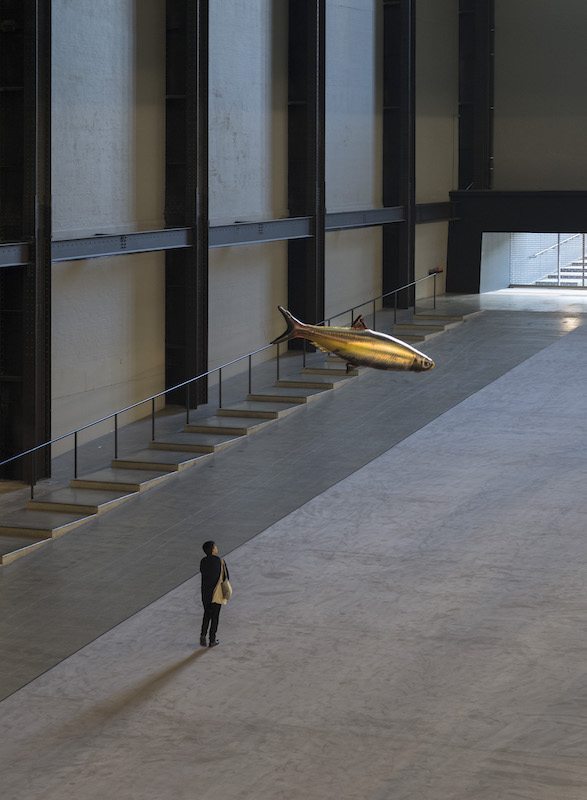Arriving at Tate Modern to visit Philippe Parreno’s ‘Anywhen’, the latest Hyundai Turbine Hall commission, I am initially confused. I had been promised an immersive, ever-changing multimedia experience of music, film and flying objects – and Parreno’s signature inflatable fish. Instead, I am met with an empty hall, save for a carpeted area above which hang rows of speakers emitting a subtle, droning noise, and visitors – lots of them – walking and standing around, sitting and lying on the grey carpet. I can’t see any fish.
Installation view of Hyundai Commission 2016: Philippe Parreno: Anywhen, 2016. Photo: Tate Photography

Over the next two hours, however, a transfixing, albeit visually simple drama begins to unfold. ‘Anywhen’ is composed of a basic series of objects brought to life through motion, light and sound: ten plain white panels, vertically and horizontally attached to the ceiling; suspended black speakers; a projector; and, if you look closely enough, a handful of small inflatable fish mostly trapped behind the Turbine Hall’s steel infrastructure. Quieter moments, such as when the panels simply float gently up and down, are no less affecting than the more explicitly spectacular ones – when, for example, the panels descend to form a canopied cinema, screening filmed footage of the ventriloquist Nina Conti, and close-ups of an alien-like creature known as a cephalopod. The moving panels, shadows flickering across their surfaces, are accompanied by a haunting soundtrack and they seem to perform a strange sort of dance, expressive and vital.
Installation view of Hyundai Commission 2016: Philippe Parreno: Anywhen, 2016. Photo: Tate Photography

A major theme of Parreno’s work is the idea of an exhibition as a living organism, not a static display of objects but a site generating experiences, interactions and memories. The sequence of unfolding events in this piece is not predetermined, but triggered by the activity of live microorganisms held in a bioreactor, responding to sensory data such as the levels of light and humidity in the Turbine Hall. Venturing to the far end of the space, visitors can peer through the glass walls and open a door into the laboratory where this alchemy is taking place (although this does not shed much light on the exact nature of the high-tech processes). In an interview about the commission, Parreno highlights another symbolic form in the exhibition: the cephalopod, a mammoth mollusc which morphs and changes colours. ‘You could say the exhibition turned a bit like a cephalopod…it’s a weird half-organic and half-mechanic and half-digital kind of machine. It’s a beast.’
‘Anywhen’ is not a massive departure for Parreno. His 2013 exhibition at the Palais de Tokyo, ‘Anywhere, Anywhere out of the World’, contained many of the same components and themes as the subsequent ‘H {N)Y P N(Y} OSIS’ at Armory 2015, and the current work at Tate Modern. Reception has been consistently divided: is Parreno’s work pure genius, or repetitive spectacle? Along similar lines, the Turbine Hall has received both lavish praise – for the ambition and popularity of its annual commissions – and condemnation. According to critics of the so-called ‘Turbine Hall effect’, artists, faced with the prospect of filling such a massive void, simply ‘scale up’ existing ideas, resulting in vast but vacuous displays that do not respond to the site in any meaningful way.
Installation view of Hyundai Commission 2016: Philippe Parreno: Anywhen, 2016. Photo: Tate Photography

On this occasion, however, Parreno has created a work that responds acutely to the Turbine Hall’s specific environment. As Parreno has commented, ‘people use the space a bit the way they use a park’. It may be that my first impression of the piece, as little more than an inhabited space, is not so far off. Throughout his career, Parreno has resisted the idea of an autonomous artwork, presented and preserved in the mausoleum of the museum. Life is central to his conception of art, from the organic mechanisms driving it (a metaphor, perhaps, for the behind-the-scenes infrastructure that keeps museums running), to the human bodies filling the exhibition space, many of them not paying attention to the main attraction (again, possibly a wry comment on the priorities of so many exhibition-goers). In ‘Anywhen’, this artistic philosophy finds the ideal home.
‘Hyundai Commission 2016: Philippe Parreno: Anywhen‘ is at the Turbine Hall, Tate Modern until 2 April 2017.



